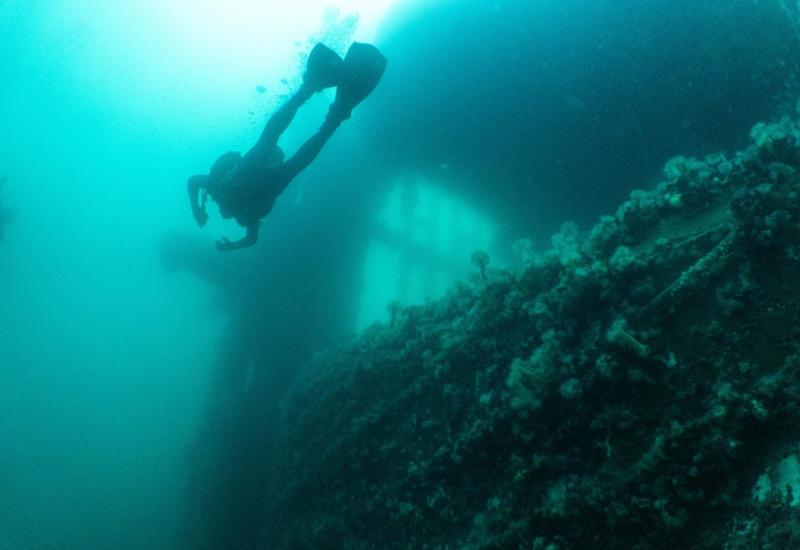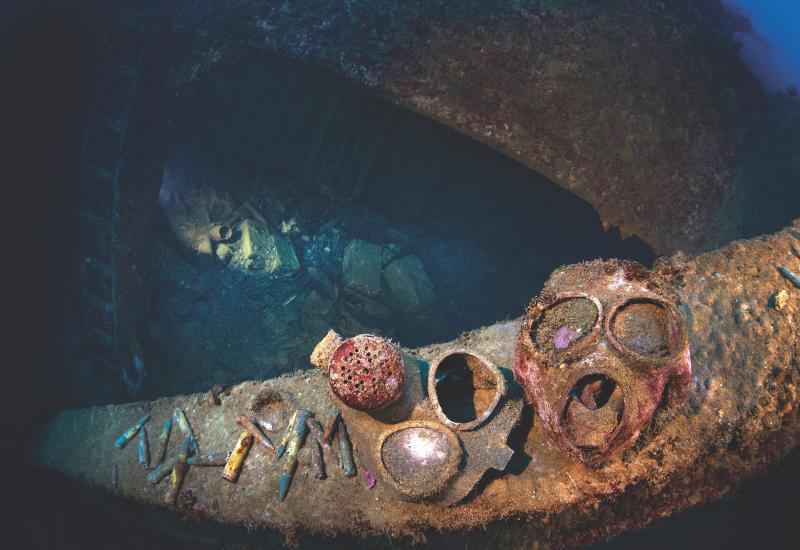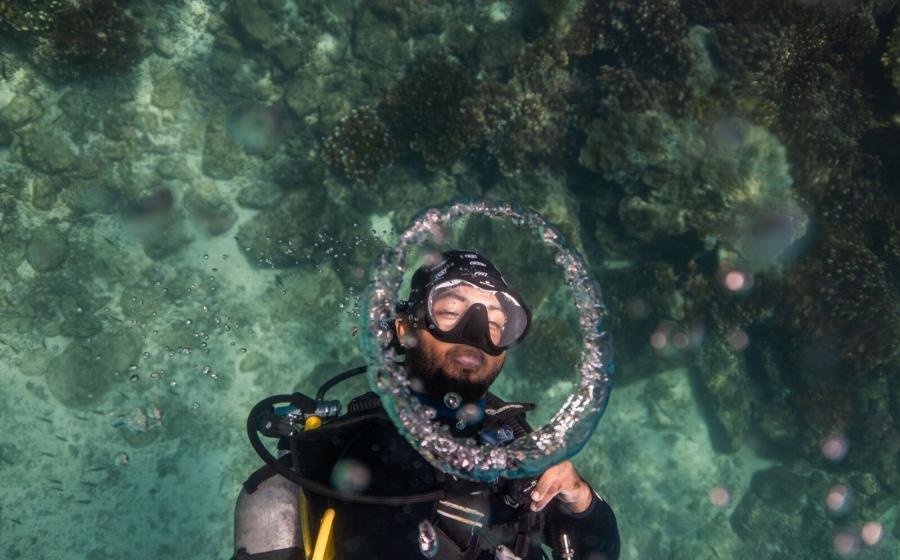The History of Grenada’s Bianca C Shipwreck

SeeThroughSeaDivers exploring the remains of the Bianca C wreck.
Scuba divers in Grenada have plenty of wrecks to choose from, but among them, one in particular dominates the conversation — the Bianca C. At almost 600 feet long, this luxury cruiser is the largest diveable wreck in the Caribbean and is often referred to by its other name — the Titanic of the Caribbean. Read on to learn how this massive luxury liner found itself submerged off the Island of Spice for scuba divers to savor.
Construction of the Bianca C
The Bianca C was a luxury cruise ship built by Provencale de Constructions Navales in La Ciotat, France, for La Messageries Maritimes of Marseille. Wreck diving website Aqua Explorers Inc. says that the ship was 593 feet long with a 75-foot beam.
Construction of the ship began in 1939 but was interrupted due to the outbreak of World War II. Dominique Serafini and Cathy Salisbury offer some insight into this period in their book Dream Wrecks. They report that the Nazi occupation of France put the in-progress ship under the command of German officers; French workers sabotaged the construction wherever they could. The Germans were so frustrated that they resorted to taking hostages just to complete the hull of the ship.
Dream Wrecks says that the hull of the unfinished ship was launched on June 10, 1944, just days after the Allied landings at Normandy. The ship was christened the Maréchal Pétain after Philippe Pétain, the French hero turned Franco-German collaborator, and towed to Port Bouc.
Operator Dive Grenada reports that the Germans torpedoed the ship during their retreat from France only two months later.
Pétain would face a life sentence at the end of the war, but the short-lived ship that bore his name would get a new lease on life. The Maréchal Pétain was raised from its shallow grave in 1946 and towed to Touloun and, later, back to La Ciotat where it was repaired and finished. The ship was renamed La Marseillaise and was finally completed in 1949.
According to the history blog Cruise Line History, La Marseillaise was powered by three-screw, Sulzer Diesel engines and could reach speeds of 22 knots at full power. Upon completion, the ship could accommodate 341 first-class passengers, 75 tourist-class passengers and 371 rationnaires (troops and economy-class passengers).
Cruise Line History offers some additional details about the ship’s design and interior. La Marseillaise had a single funnel and a new kind of rounded bow. The ship’s interior design was inspired by Saigon, Vietnam — one of the stops on the ship’s initial cruise itinerary. The first-class cafe was decorated with specially made ceramics and filled with plants to make it feel like a tropical garden. Other features and amenities listed by Cruise Line History include a walnut paneled smoking room, veranda cafe with large windows overlooking the bow, pool and domed dining salon with a grand staircase.
Bianca C’s History on the Water
La Marseillaise embarked on its maiden voyage as the flagship of Messageries Maritimes on August 18, 1949. Dive Grenada reports that the ship’s first voyage took it from Marseille, France, to Yokohama, Japan. Cruise Line History says that the ship rivaled other impressive cruise liners of its era and was the largest and fastest ship yet built for Messageries Maritime.
Cruise Line History reports that changing political relations between France and Southeast Asia during the 1950’s resulted in fewer travelers onboard La Marseillaise. The ship was repurposed briefly as a hospital ship during the crisis over the Suez Canal before being retired from service.
In 1957 Messageries Maritime sold the ship to the Panama-based Arosa Line. The ship was reconfigured to hold only two classes of passengers. Once renovated, Cruise Line History reports, the ship could accommodate 202 first-class passengers and 1,030 second-class passengers. Along with the internal changes the ship’s name was also updated, and on May 10, 1957, the company’s new flagship, the Arosa Sky, made its debut with a voyage between Bremerhaven, Germany, and New York.
The Arosa Line found itself in finical straits two years later and the company ended up selling the ship to the Costa Line, based out of Genoa, Italy, in 1959. The ship went through another refitting in order to keep it up to the standards of the day and to slightly increase its gross tonnage. During this time, the ship was rechristened the Bianca C. Cruise Ship History reports that the ship was named after the company manager’s daughter; according to wreck database Wrecksite, this was the second ship in the Costa line to bear that name.
Bianca C served in the Costa Line for two years and ran from Naples, Italy to Guaira, Venezuela.
The Sinking of the Bianca C
Dive Grenada reports that the Bianca C departed on its final voyage on October 12, 1961. Ten days later, the ship was anchored off St. George’s, Grenada — the last stop on its return journey — but would never leave the island.
On the morning of Sunday, October 22, there was an explosion in the ship’s main boiler room; the resulting fire quickly spread throughout the ship.
The residents of St. George’s were awakened by the sound of the explosion and quickly sprang into action. Soon a flotilla of boats arrived to ferry passengers to safety. This makeshift fleet included local vessels of all stripes, from luxury yachts to simple fishing skiffs.
The Grenadian rescue effort was successful and all 672 people aboard were evacuated. The only soul lost onboard the Bianca C was a crewman who died in the initial explosion. Several survivors needed medical attention after suffering severe burns; Cruise Line History reports that two crewmen later died as a result of their injuries.
Relieved of its passengers, Bianca continued to burn. It is said that the fire was so hot that the ship’s paint began to bubble and the hull glowed red. The heat was so intense that the seawater around the ship began to boil.
Aqua Explorers reports that Bianca’s captain, Francisco Gravato, attempted to quench the flames, but was unsuccessful. The Grenadians just weren’t equipped to handle such a large fire. The HMS Londonderry, a British frigate stationed in Puerto Rico, was dispatched to help. It would take the frigate two days to travel to Grenada, and the Bianca C burned all the while.
The Bianca was anchored in St. George’s main shipping lanes and would cause a navigational hazard if it sank there. When the Londonderry finally arrived the crew bravely boarded the still-flaming ship in order to attach tow lines and cut its anchor free.
Londonderry then attempted to beach the luxury liner off Point Salines, but the towing process was slow going due to the weather and because the Bianca C’s rudder had been damaged in the fire. The towline broke during a squall and Bianca veered off to starboard. Before another tow line could be established, the ship unceremoniously slipped beneath the waves. On October 24, 1961, after burning for two straight days, the Bianca C finally succumbed to the deep.
The Aftermath of the Sinking
The large influx of visitors from the sunken cruise liner was more than the island’s tourist infrastructure could handle. In a true show of Grenadian hospitality, the army of castaways was welcomed with open arms into the homes of local families. Grenadians fed and clothed their unexpected guests until the visitors were finally able return home.
Grateful for the islanders’ generosity, the Costa Line thanked them with a gift — a replica of the Christ of the Abyss statue by Guido Galletti that was installed in the Mediterranean Sea near Genoa, Italy. The replica statue, originally placed in St. George’s harbor, now stands on the Carenage harbor with its arms outstretched toward the sea. In 2011, local artist Troy Lewis created a model of the statue for its 50th anniversary. The model was installed in Grenada’s underwater sculpture park in Molinere Bay for snorkelers and scuba divers to visit.
Diving the Bianca C
The Bianca C’s final resting place is about a mile off the southwestern shore of Grenada — one of the closest dive operators, Sandals Grenada, is only a 10-minute boat ride away. The wreck sits in 167 feet of water and rests upright on its keel. Even though the ship is gigantic, the top of it only reaches to around 90 feet. There are no mooring buoys, and currents in the area can be strong and unpredictable. This wreck is typically done as a drift dive.
The most common entry method for this dive is a paratrooper-style negative entry. As divers hit the water, one right after the other, they kick like mad to hasten their descent before they drift off the wreck. Of course, Bianca is deep enough that you won’t be able to gauge whether you’ve hit the mark or not until you reach about 80 feet. The chaotic start, depth and current make this an advanced dive.
Once the massive wreck comes into view it quickly envelops your entire field of vision. Without being able to see the ship in its entirety, the broken-up decks begin to look like some alien landscape — it feels like you are in another world. Large openings framed with lush growths of black coral allow glimpses into the interior maze of walkways and railings far below. Divers typically stop to take a dip in the ship’s swimming pool, which sits just below 125 feet. Other sights include the ship’s bow and funnel. However, most divers will be content to simply marvel at the sheer size of the wreck.
Weather and age have taken their toll on the Bianca C and the ship has deteriorated over the years. The bridge has been completely flattened and the rear third of the ship has fallen away. Structural integrity is a growing concern, and while there may be some spaces left to penetrate, it is not recommended.
Eagles rays, nurse sharks, barracuda, large moray eels and Atlantic spadefish are common sights.
Due to the current and depth, you likely won’t get more than 10 or 15 minutes on the wreck itself. Fortunately, the ship rests at the base of Whibbles Reef, which provides a nice backdrop to gaze upon as you make your ascent. But don’t be surprised if you get the urge to look over your shoulder to try and get one last look at the titan resting below.
Depth: The wreck starts at 90 feet and goes down to nearly 167 feet.
Visibility: Depending on conditions, visibility usually ranges between 60 and 180 feet.
Temperature: Water temperatures can be between 79- and 86-degrees Fahrenheit.
Need to Know: Due to the advanced nature of this dive, dive operators may require a check-out dive prior to visiting the wreck, especially for divers who have been out of the water for a while.
Operators: Sandals Grenada, Dive Grenada, ScubaTech Grenada










